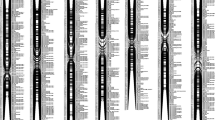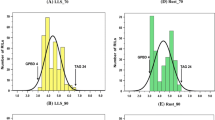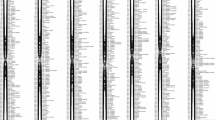Abstract
With the development of genetic maps and the identification of the most-likely positions of quantitative trait loci (QTLs) on these maps, molecular markers for lodging resistance can be identified. Consequently, marker-assisted selection (MAS) has the potential to improve the efficiency of selection for lodging resistance in a breeding program. This study was conducted to identify genetic loci associated with lodging resistance, plant height and reaction to mycosphaerella blight in pea. A population consisting of 88 recombinant inbred lines (RILs) was developed from a cross between Carneval and MP1401. The RILs were evaluated in 11 environments across the provinces of Manitoba, Saskatchewan and Alberta, Canada in 1998, 1999 and 2000. One hundred and ninety two amplified fragment length polymorphism (AFLP) markers, 13 random amplified polymorphic DNA (RAPD) markers and one sequence tagged site (STS) marker were assigned to ten linkage groups (LGs) that covered 1,274 centi Morgans (cM) of the pea genome. Six of these LGs were aligned with the previous pea map. Two QTLs were identified for lodging resistance that collectively explained 58% of the total phenotypic variation in the mean environment. Three QTLs were identified each for plant height and resistance to mycosphaerella blight, which accounted for 65% and 36% of the total phenotypic variation, respectively, in the mean environment. These QTLs were relatively consistent across environments. The AFLP marker that was associated with the major locus for lodging resistance was converted into the sequence-characterized amplified-region (SCAR) marker. The presence or absence of the SCAR marker corresponded well with the lodging reaction of 50 commercial pea varieties.




Similar content being viewed by others
References
Bassam BJ, Caetano-Anolles G, Gresshoff PM (1991) Fast and sensitive silver staining of DNA in Polyacrylamide gels. Anal Biochem 196:80–83
Basten CJ, Weir BS, Zeng ZB (1994) Zmap—a QTL cartographer. Proc 5th World Congress on Genetics Applied to Livestock Production: Computing Strategies and Software, Vol. 22. In: Smith C, Gavora JS, Benkel B, Chesnais J, Fairfull W, Gibson JP, Kennedy BW, Burnside EB (eds) 5th World Congress on Genetics Applied to Livestock Production, Guelph, Ontario, Canada, pp 65–66
Bretag TW, Keane PJ, Price TV (1995) Effect of ascochyta blight on the grain yield of field peas (Pisum sativum L.) grown in Southern Australia. Aust J Exp Agric 35:531–536
Chalhoub BA, Thibault S, Laucou V, Rameau C, Hofte H, Cousin R (1997) Silver staining and recovery of AFLP amplification products on large-denaturing polyacrylamide gels. BioTechniques 22:216–220
Churchill GA, Doerge RW (1994) Empirical threshold values for quantitative trait mapping. Genetics 138:963–971
Dirlewanger E, Isaac PG, Ranade S, Belajouza M, Cousin B, de Vienne D (1994) Restriction fragment length polymorphism analysis of loci associated with disease resistance genes and developmental traits in Pisum sativum L. Theor Appl Genet 88:17–27
Ellis THN, Turner L, Hellens RP, Lee D, Harker CL, Enard C, Domoney C, Davies DR (1992) Linkage maps in pea. Genetics 130:649–663
Gilpin BJ, McCallum JA, Frew TJ, Timmerman-Vaughan GM (1997) A linkage map of the pea (Pisum sativum L.) genome containing cloned sequences of known function and expressed sequence tags (ESTs). Theor Appl Genet 95:1289–1299
Hall KJ, Parker JS, Ellis THN, Turner L, Knox MR, Hofer JMI, Lu J, Ferrandiz C, Hunter PJ, Taylor JD, Baird K (1997) The relationship between genetic and cytogenetic maps of pea. II. Physical maps of linkage-mapping populations. Genome 40:755–769
Kim HS, Diers BW (2000) Inheritance of partial resistance to sclerotinia stem rot in soybean. Crop Sci 40:55–61
Lander ES, Green P, Abrahamson J, Barlow A, Daly MJ, Lincoln SE, Newburg I (1987) Mapmaker: an interactive computer package for constructing primary genetic linkage maps of experimental and natural population. Genomics 1:174–181
Laucou V, Haurogné K, Ellis N, Rameau C (1998) Genetic mapping in pea. 1. RAPD-based genetic linkage map of Pisum sativum. Theor Appl Genet 97:905–915
Lee SH, Bailey MA, Mian MAR, Shipe ER, Ashley DA, Parrot WA, Hussey RS, Boerma HR (1996) Identification of quantitative loci for plant height, lodging, and maturity in a soybean population segregating for growth habit. Theor Appl Genet 92:516–523
Mansur LM, Lark KG, Kross H, Oliveira A (1993) Interval mapping of quantitative trait loci for reproductive, morphological, and seed traits of soybean (Glycine max L.). Theor Appl Genet 86:907–913
McCallum J, Timmerman-Vaughan GM, Frew TJ, Russell AC (1997) Biochemical and genetic linkage analysis of green seed color in field pea (Pisum sativum L.). J Am Soc Hort Sci 122:218–225
McPhee KE, Muehlbauer FJ (1999) Stem strength in the core collection of Pisum germplasm. Pisum Genet 31:21–24
Murfet IC, Reid JB (1993) Developmental mutants. In: Casey R, Davies DR (eds) Peas: genetics, molecular biology and biotechnology. CAB International, Wallingford, UK, pp 165–216
Pilet-Nayel ML, Muehlbauer FJ, McGee RJ, Kraft JM, Baranger A, Coyne CJ (2002) Quantitative trait loci for partial resistance to Aphanomyces root rot in pea. Theor Appl Genet 106:28–39
Rameau C, Dénoue D, Fraval F, Haurogné K, Josserand J, Laucou V, Batge S, Murfet IC (1998) Genetic mapping in pea. 2. Identification of RAPD and SCAR markers linked to genes affecting plant architecture. Theor Appl Genet 97:916–928
Saghai-Maarof MA, Soliman KM, Jorgensen R, Allard RW (1984) Ribosomal DNA spacer-length polymorphisms in barley: Mendelian inheritance, chromosomal location, and population dynamics. Proc Natl Acad Sci USA 81:8014–8018
Sherriff LJ, McKay MJ, Ross JJ, Reid JB, Willis CL (1994) Decapitation reduces the metabolism of gibberellin A20 to A1 in Pisum sativum L., decreasing the Le/le difference. Plant Physiol 104:277–280
Tar'an B, Michaels TE, Pauls KP (2002) Genetic mapping of agronomic traits in common bean (Phaseolus vulgaris L.). Crop Sci 42:544–556
Timmerman-Vaughan GM, McCallum JA, Frew TJ, Weeden NF, Russel AC (1996) Linkage mapping of quantitative loci controlling seed weight in pea (Pisum sativum L.). Theor Appl Genet 93:431–439
Timmerman-Vaughan GM, Frew TJ, Weeden NF (2000) Characterization and linkage mapping of R-gene-analogous DNA sequences in pea (Pisum sativum L.). Theor Appl Genet 101:241–247
Timmerman-Vaughan GM, Frew TJ, Russell AC, Khan T, Butler R, Gilpin M, Murray S, Falloon K (2002) QTL mapping of partial resistance to field epidemics of ascochyta blight of pea. Crop Sci 42:2100–2111
Wang SC, Zheng ZB, Basten CJ, Weir BS (1999) QTL cartographer for windows version 1.01. Department of Statistics, North Carolina State University, Raleigh, North Carolina
Weeden NF, Ellis THN, Timmerman-Vaughan G.M, Swiecicki WK, Rozov SM, Berdnikov VA (1998) A consensus linkage map for Pisum sativum. Pisum Genet 30:1–4
Wroth JM (1999) Evidence suggests that Mycosphaerella pinodes infection of Pisum sativum is inherited as a quantitative trait. Euphytica 107:193–204
Xue AG, Warkentin TD (2001) Partial resistance to Mycosphaerella pinodes in field pea. Can J Plant Sci 81:535–540
Xue AG, Warkentin TD, Greeniaus MT, Zimmer RC (1996) Genotypic variability in seed-borne infection of field pea by Mycosphaerella pinodes and its relation to foliar disease severity. Can J Plant Pathol 18:370–374
Acknowledgements
Financial support from the Western Grains Research Foundation is gratefully acknowledged. We thank Al Sloan, Brent Barlow and Rob Kirkpatrick for their technical expertise.
Author information
Authors and Affiliations
Corresponding author
Additional information
Communicated by H. F. Linskens
Rights and permissions
About this article
Cite this article
Tar'an, B., Warkentin, T., Somers, D.J. et al. Quantitative trait loci for lodging resistance, plant height and partial resistance to mycosphaerella blight in field pea (Pisum sativum L.). Theor Appl Genet 107, 1482–1491 (2003). https://doi.org/10.1007/s00122-003-1379-9
Received:
Accepted:
Published:
Issue Date:
DOI: https://doi.org/10.1007/s00122-003-1379-9




